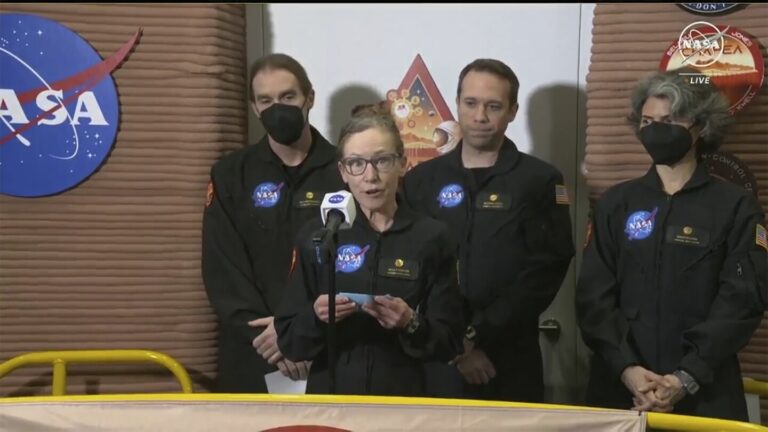The crew of NASA’s Mars exploration mission have emerged from their spacecraft after a year-long voyage without leaving Earth.
The four-volunteer crew spent more than 12 months in NASA’s first-ever simulated Mars environment at the Johnson Space Center in Houston, emerging from the artificial alien environment at about 5pm on Saturday.
Kelly Haston, Anka Serariu, Ross Brockwell and Nathan Jones will enter the 3D-printed habitat as the space agency’s first flight crew on June 25, 2023. Crew Health and Performance Exploration Analogue project.
Haston, the mission commander, began with a simple greeting: “Hello.”
“I’m so happy to be able to say ‘hello’ to everyone,” she said.
Jones, a doctor and medical director at the mission, said the 378 days in detention “just flew by.”
The four lived and worked within the 17,000-square-foot (1,579-square-meter) space to simulate a mission to the Red Planet, which is the fourth planet from the sun and is a hot topic of much discussion among scientists and science fiction fans about the possibility of humans traveling beyond the moon.
CHAPEA’s first crew focused on establishing possible conditions for future Martian activity through a simulated spacewalk known as a “Marswalk,” as well as growing and harvesting vegetables to supplement their food supply and maintaining their habitat and equipment.
They also addressed the challenges a real Mars crew would face, including limited resources, isolation, and up to 22-minute delays in communications with their home planet beyond the habitat’s walls, according to NASA.
Two more CHAPEA missions are planned, during which the crew will continue to conduct simulated spacewalks and gather data on factors related to physical and behavioral health and performance, NASA said.
Steve Corner, deputy director of the Johnson Space Center, said much of the first crew’s experiments focused on nutrition and how it affects their performance, a research he called “critically important science as we prepare to send humans to Mars.”
“They are separated from their families, put on carefully determined meal plans and are under a lot of observation,” Corner said.
“Mars is our goal,” he said, calling the project a significant step in America’s intention to become a leader in global space exploration efforts.
Astronaut Kjell Lindgren, deputy director of flight operations, knocked on the habitat door, and the four volunteers answered, speaking of their gratitude for each other, their thanks to those who had waited patiently outside, and the lessons they had learned about future manned missions to Mars and life on Earth.
Brockwell, the crew’s flight engineer, said the mission taught them the importance of living sustainably for the benefit of all people on Earth.
“I’m so grateful for this incredible opportunity to spend a year in the spirit of global adventure towards an exciting future, and to put into practice the idea that we should never use resources faster than we can replenish them, and we should never generate waste faster than we can reprocess it into resources,” Brockwell said.
“Without following these principles we cannot live, dream, create or explore for long periods of time, but if we do follow them we can achieve and sustain amazing and inspiring things, like exploring other worlds,” he said.
Science officer Anka Serariu said he had been asked many times why they were so keen on Mars.
“Why go to Mars? Because it’s possible,” she says. “Because space can bring us together and bring out the best in us. Because it’s a crucial step for ‘Earthlings’ to light the way for the next century.”

